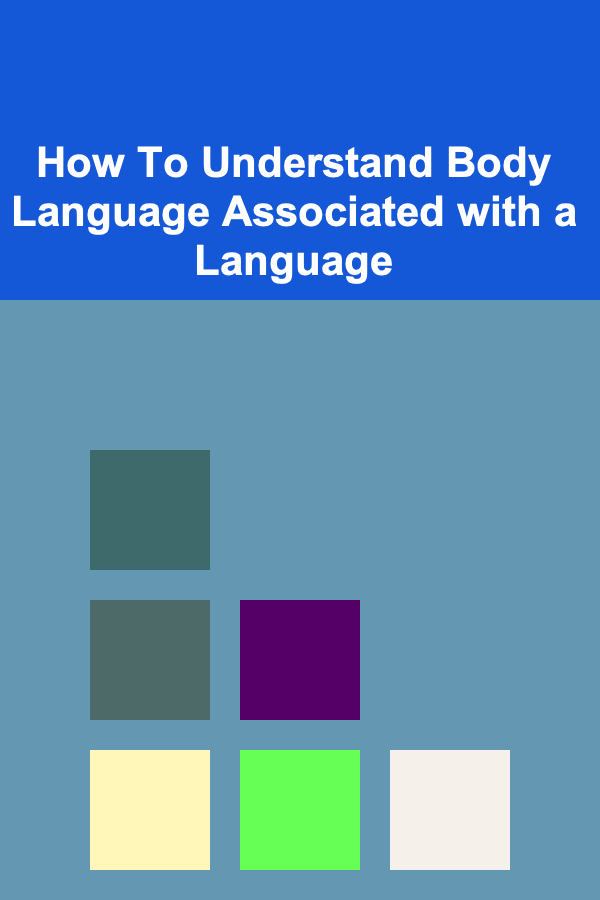
How To Understand Body Language Associated with a Language
ebook include PDF & Audio bundle (Micro Guide)
$12.99$7.99
Limited Time Offer! Order within the next:

Understanding body language is a vital aspect of communication that transcends the spoken word. It complements verbal communication, enriches understanding, and offers insights into unspoken feelings and intentions. However, body language varies significantly across cultures, regions, and even individual personalities. This article explores how to understand body language associated with a language, providing a detailed analysis of its importance, its role in communication, and strategies to interpret it accurately in different cultural and linguistic contexts.
The Importance of Body Language in Communication
Body language is often referred to as a silent language. It encompasses facial expressions, gestures, posture, eye contact, and even the tone of voice. In some studies, it has been suggested that a large percentage of human communication is non-verbal. Albert Mehrabian's research on communication indicates that about 93% of communication can be non-verbal, with 55% of the message conveyed through body language, 38% through tone of voice, and only 7% through actual words.
Non-Verbal Signals Complement Words
While words carry the semantic meaning, non-verbal cues express the emotional undertones and provide context. For instance, a person might say, "I'm fine," but if their body language---such as slumped shoulders, avoiding eye contact, or a flat tone---suggests otherwise, the listener can interpret that the individual is not truly fine. Similarly, when someone uses hand gestures while speaking, it may add emphasis or clarity to the message.
Culture and Body Language
Cultural differences play a significant role in how body language is understood. A gesture that conveys one message in one culture might convey an entirely different message in another. For example, the "thumbs up" gesture, which is a sign of approval or agreement in many Western cultures, is offensive in some Middle Eastern countries. This highlights the importance of cultural awareness in understanding body language.
Key Aspects of Body Language
Understanding body language associated with a language requires a deep dive into various aspects of non-verbal communication. These aspects include facial expressions, gestures, posture, eye contact, and proxemics.
1. Facial Expressions
Facial expressions are one of the most universal forms of body language. Humans express emotions such as happiness, sadness, anger, surprise, fear, and disgust through their faces. These expressions are typically consistent across cultures, as they are deeply rooted in human biology and evolutionary psychology.
- Happiness is often expressed through a smile, with raised eyebrows and crinkled eyes.
- Sadness may be conveyed through drooping eyelids, a downturned mouth, and a furrowed brow.
- Anger can be identified by flared nostrils, clenched jaw, and furrowed brow.
- Surprise is typically shown by wide eyes, raised eyebrows, and an open mouth.
In different languages, words are often associated with particular emotions, but the underlying facial expressions can signal the true emotional state, regardless of the language spoken.
2. Gestures
Gestures are another essential part of body language. They are hand movements, facial expressions, or other actions that convey specific messages. Some gestures are universally understood, while others are culturally specific.
- Thumbs Up: As mentioned, this gesture is generally positive in many cultures but can be offensive in others.
- OK Sign: In the U.S., the "OK" hand gesture means agreement or that everything is fine, but in some cultures, it can be considered vulgar or a sign of disrespect.
- Peace Sign: In Western cultures, raising two fingers in a "V" shape often signifies peace or victory, but in certain countries, showing this gesture with the palm facing inward is considered offensive.
Understanding these gestures is crucial for interpreting communication effectively in a multilingual context. The meaning of the same gesture can shift dramatically based on where you are in the world.
3. Posture
A person's posture can reveal a lot about their mood, intentions, and level of engagement in a conversation. For example:
- Open Posture: Standing or sitting with arms uncrossed, shoulders back, and an upright stance typically conveys confidence, openness, and receptivity.
- Closed Posture: Crossing arms or legs, slouching, or keeping a hunched posture can indicate defensiveness, discomfort, or lack of interest.
Posture is also a key aspect of body language that can differ across cultures. In some cultures, maintaining a straight posture is seen as a sign of respect, while in others, a more relaxed or informal posture may be preferred.
4. Eye Contact
Eye contact is one of the most powerful tools of non-verbal communication. It helps convey interest, attentiveness, and emotional connection. The way eye contact is used can vary greatly depending on the cultural context:
- Western Cultures: In many Western cultures, maintaining eye contact during a conversation shows attentiveness and confidence. Avoiding eye contact may be perceived as evasiveness or lack of interest.
- Asian Cultures: In contrast, in some Asian cultures, direct eye contact can be seen as rude or challenging, especially when talking to someone in a position of authority. Looking down or slightly to the side can be a sign of respect.
It's essential to be aware of these cultural differences to avoid misinterpretations, especially in multilingual and multicultural settings.
5. Proxemics (Personal Space)
Proxemics refers to the use of space in communication and varies significantly across cultures. It relates to the distance people maintain during social interactions.
- Close Proximity: In some cultures, such as those in the Middle East or Latin America, people tend to stand or sit very close to each other during conversations, which may signify warmth or intimacy.
- Greater Personal Space: In contrast, many Northern European cultures or North American cultures value personal space and may feel uncomfortable when others stand too close.
Understanding the appropriate personal space in different cultures can prevent discomfort and help build rapport during conversations.
How Language and Body Language Interact
Body language is deeply intertwined with language itself. The words we choose to speak are often accompanied by a corresponding set of body movements that reinforce the message. In certain cases, body language can also replace verbal communication entirely.
1. Emphasis and Reinforcement
In both verbal and non-verbal communication, body language can serve to emphasize or reinforce what is being said. For instance, if someone says, "I'm really excited about this project," while jumping up and down or smiling broadly, their body language emphasizes the enthusiasm behind their words. Conversely, if someone speaks in a monotone voice while sitting still, their body language and verbal tone may suggest a lack of interest or excitement.
2. Substituting for Words
In some situations, body language can completely substitute verbal communication. For example, a person might shake their head to signal "no" without saying a word, or raise their hand to indicate they wish to speak. These non-verbal cues play a vital role in allowing people to communicate without speaking.
3. Complementing the Verbal Message
Body language can complement and complete a verbal message by adding nuance and emotional depth. A simple statement like "I'll be there" may be interpreted differently depending on the accompanying body language. If said while looking away with a distant tone, the listener may infer uncertainty or lack of commitment. But if said with a confident stance and steady eye contact, it reinforces a sense of assurance and reliability.
Understanding Body Language Across Cultures and Languages
Given that body language is culturally specific, it is important to recognize how it might differ across various linguistic and cultural settings.
1. Misinterpretation Risks
Without an understanding of cultural norms, body language can be misinterpreted. For example, in some Latin American and Mediterranean cultures, touching during conversation is common, and it signifies warmth and friendship. However, in cultures like those in Japan or the UK, such physical contact might be uncomfortable or even viewed as intrusive. This discrepancy can lead to misunderstandings if the cultural context is not understood.
2. Learning Local Nuances
When learning a new language, it's essential to understand the non-verbal communication associated with it. For example, in some cultures, indirect body language, such as not making direct eye contact, is a sign of respect. Similarly, the way gestures are used in one language may be completely different in another. For instance, a simple head nod might indicate agreement in some cultures, but in others, it could mean "maybe" or "I'm listening."
3. Integrating Body Language in Language Acquisition
For language learners, integrating body language into language acquisition can enhance comprehension and fluency. Practicing gestures and facial expressions associated with the language, as well as observing native speakers' body language, can provide deeper insights into the cultural and emotional context of the language. Furthermore, body language serves as a bridge for communication in situations where one might lack the vocabulary to express something fully.
Conclusion
Understanding body language associated with a language is an invaluable skill for enhancing communication and building stronger connections with others. Non-verbal cues not only reinforce spoken words but also provide additional context, allowing individuals to interpret emotions, intentions, and meanings more accurately. As language learners, recognizing the importance of body language and cultural variations in non-verbal communication can significantly enhance one's ability to engage with others in a meaningful and respectful manner.
By being aware of facial expressions, gestures, posture, eye contact, and proxemics, individuals can unlock the full potential of communication, bridging linguistic and cultural gaps while avoiding misunderstandings. The interplay between verbal and non-verbal communication ultimately enriches human interaction, creating a more harmonious and effective way to understand and connect with others across languages and cultures.

How to Build Custom Shelving Units for Any Room
Read More
How to Maintain Your Home's Fencing and Gates
Read More
How to Profit from Your Photography Skills
Read More
How To Understand the Search for Dark Matter Candidates
Read More
Mastering the Eisenhower Matrix: An In-Depth Guide to Prioritization
Read More
Patient Advocacy for Specific Conditions: 5 Niche Areas to Consider
Read MoreOther Products

How to Build Custom Shelving Units for Any Room
Read More
How to Maintain Your Home's Fencing and Gates
Read More
How to Profit from Your Photography Skills
Read More
How To Understand the Search for Dark Matter Candidates
Read More
Mastering the Eisenhower Matrix: An In-Depth Guide to Prioritization
Read More